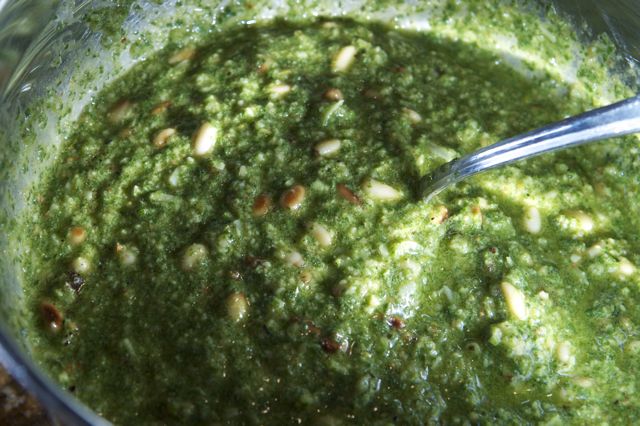Pesto Genovese
Note to readers: This is an excerpt from my book, American Pie: My Search for the Perfect Pizza (Ten Speed Press). This recipe is one of my most requested and I think it rivals any pesto recipe I’ve seen or tried anywhere. Let me know what you think when you try it.
My favorite pesto memory in the United States was at the legendary Caffe Sport in North Beach during its glory years in the 1970’s when Tony Latona was alive, roaming back and forth between the kitchen and the dining room. His pesto was bright green, the basil flavor exploded in my mouth, carried by the cheese and pine nut base notes. A lot of restaurant pesto now is a dull green, thick and pasty, the flavors locked up, trapped in the cheese. It had been a long time since pesto sent me into ecstasy but when it was served to us at Ristorante da Vittorio in the town of Recco over some toothsome troffie pasta, I felt as though
time had compressed and I was discovering it anew, like my first time at Caffe Sport.

Pesto Genovese with whole toasted Pine Nuts
2 cups (tightly packed) fresh basil leaves, washed thoroughly
8 cloves fresh garlic, minced, not pressed, lightly sauteed in a tablespoon of olive oil (to take out the “hotness”)
1 cup extra virgin olive oil
1 1/2 tablespoons fresh lemon juice
3/4 cup freshly grated parmesan, romano, or grana padana cheese (do not use pre-grated, box cheese)
1 cup pine nuts, lightly toasted
salt and pepper to taste
Place all the ingredients in a food processor (not a blender) and process for about 30 seconds, or until smooth. Add more olive oil if it is too thick; add more grated cheese if it is too thin (lately, I’ve been using Bel Gioioso Grana for my dry aged cheese needs–nice flavor and acidity). Add salt and pepper to taste, but the cheese provides enough salt for most people, and pepper is optional.
An option is to hold back half of the toasted pine nuts and grated cheese and fold them into the pesto after it has been processed. This adds another layer of texture–little flavor bursts of toasted nuts and salty cheese. (Note: you can substitute toasted walnuts for the pine nuts if you prefer)
Keep the pesto in a tightly covered container in the refrigerator. It will be good for up to a week. If the top surface darkens, this is just oxidation–simply stir it back in–it should be bright green underneath, However, if you freeze it, it will remain bright green until you thaw it, at which time it will darken throughout (more oxidation). You can still use it but it won’t be as vibrant looking (but dark pesto is better than no pesto at all–perhaps stir in a little lemon juice). You can also replace some of the fresh basil with other fresh green herbs, such as parsley or arugula or a very small amount of stronger herbs such as fresh oregano or marjoram. Roasted red peppers can also be substituted, to taste.
Recent Articles by Peter Reinhart
- “Tommy & Atticus” in Redondo Beach, CA. A Sourdough Success Story
- Howard Brownstein on Turnaround and Crisis Management
- Randy Clemens and Forest Farming in Uruguay — The Back to The Earth Movement is Back!
- It’s not too late to chase your dreams: “Pizza From the Heart” A New Book by Paulie and Mary Ann Gee
- Kyle Ahlgren on the Artisan Baking Center Online Classes (and a special offer)
- Multi-James Beard Nominee Cathy Whims of Portland’s Nostrana and her Brand New Book
Add Comment
You must be logged in to post a comment.










Solid pesto recipe. If you want to add a little food science to it: in a mortar, pound one vitamin c tablet into complete powder. Add this to the mix. Vitamin C is a powerful antioxidant and will preserve the color for a long time. It also adds some tartness like lemon juice. Lemon juice is also a good source of vitamin C and citric acid (a good antioxidant). You just need to add a lot to get the same effect.
I make the whole thing in the mortar. It’s chunkier and kind of rustic and builds muscle.
Great website
Yes, a mortar and pestle is the real deal. Pesto actually means “pounded” and thus the term “pestle” for the pounding tool. I use the food processor simply because it’s faster, but there’s nothing like the primalness of pounding and smelling those aromas as they are volatized and released.
That’s a great tip on the Vitamin C. What strength pill do you use and is it ascorbic acid Vitamin C that you use?
yum sounds great! Isn’t 8 cloves too much though? I usually use one or two, more than that is usually too strong. Is the sauteing the trick? Also can this be done with a hand blender?
btw love the site!
1000 mg Ascorbic acid. Make sure it’s only vitamin C. No added rose hips or b complex. You will get some very bad flavors from other vitamins. You can also get pure from some places on line. Le Sanctuaire has a liquid form. http://www.le-sanctuaire.com/mm5/merchant.mvc?Screen=PROD&Store_Code=ls&Product_Code=4MAscorbicAcid&Category_Code=Acidifiers
As for the garlic, yes, lightly sauteing it in olive oil is my secret trick for how to get more garlic in without burning our mouths or offending our loved ones. It takes the “burn” out. But really, just a quick. light saute, not for browning, just for about thirty seconds so you get max flavor without the burn. Try it and let us know what you think.